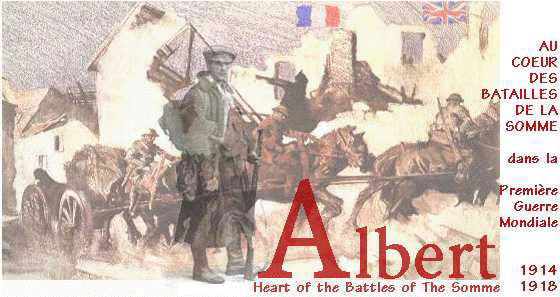
The Battle of The Somme 1916
London News Radio 01-07-1996

The 100th anniversary of the outbreak of the First World War took place in 2014 but this article was written in 1996 to commemorate the 80th anniversary of the Battle of The Somme in 1916.
Visitors from Britain and the Commonwealth are exploring the battlefields of The Somme in greater numbers than ever before. Are they really searching for great-uncle Frank or for something lost and buried far deeper? Christopher Long makes another of his frequent visits to the battlefields of World War l.
By Christopher Long
See Review of World War l Videos

A
t precisely 7.28 am on 1 July, 1916, the 179th Tunnelling Company of The Royal Engineers detonated 60,000 lbs of ammonal at the end of a tunnel 52 feet below the German lines on The Somme. The resulting colossal explosion could be heard as far away as the Channel ports and, following the similar explosion on 'Hawthorn Ridge', signalled the start, two minutes later, of the greatest mass slaughter in British military history.
Today, literally in a corner of a foreign field, just a few hundred yards south of the tiny village of La Boisselle and at the epicentre of the battle, 'Lochnagar Crater' survives as a huge, useless, empty hole – 300 ft wide and 90 ft deep.
The local population were mildly baffled when, in 1978, an apparently eccentric Englishman, Richard Dunning, offered to buy and preserve this vast crater. With EC farm subsidies and crop yields uppermost in their minds, the already fabulously prosperous farmers were busy filling in an identical crater, 'Y Sap', on the other side of the village.
Quite simply, this giant empty space holds a poignant fascination for British visitors, an obsession which seems to be almost entirely lost on the French.
Anyone standing on its 15 ft high lip, staring down into the void, clearly knows they are looking at an eloquently silent testimony to the futility of war. But could it be that somewhere deep in our British collective subconscious we also recognise that it was here, at that precise moment, that Britain began to lose her way as her power and prestige finally haemorrhaged into the soil of Europe?
 The map right shows the full length of the Western Front which moved backwards and forwards between 1914 and 1918. The British Sector covered the north (the white rectangles) from the Somme Valley to the English Channel and was the scene of the great battles of The Somme (around Albert), Pachendale and Ypres (known to soldiers as 'Wipers' and today called Ieper). The greatest battle in the French Sector was in the Verdun 'salient'. The end came on 11 November 1918 with the signing of the Armistice in a railway carriage in the woods at Compiegne. Twenty-two years later this same location was symbolically chosen by Hitler, in 1940, for France formally to sign its capitulation to Germany's advancing troops. The Somme battles could be regarded as a colossal military defeat for Britain – though without it there would almost certainly not have been the ultimate victory over German forces in 1918.
The map right shows the full length of the Western Front which moved backwards and forwards between 1914 and 1918. The British Sector covered the north (the white rectangles) from the Somme Valley to the English Channel and was the scene of the great battles of The Somme (around Albert), Pachendale and Ypres (known to soldiers as 'Wipers' and today called Ieper). The greatest battle in the French Sector was in the Verdun 'salient'. The end came on 11 November 1918 with the signing of the Armistice in a railway carriage in the woods at Compiegne. Twenty-two years later this same location was symbolically chosen by Hitler, in 1940, for France formally to sign its capitulation to Germany's advancing troops. The Somme battles could be regarded as a colossal military defeat for Britain – though without it there would almost certainly not have been the ultimate victory over German forces in 1918.
Most French people are quite unaware that around 750,000 British Empire troops died on the Western Front in the defence and ultimate liberation of France and Belgium. Britain suffered 60,000 casualties – 20,000 killed – on the 1st July 1916 alone.
It's worth noting the considerable differences between the strategies employed by the French and British sectors.
The French 'strategy' in 1914-15 involved nothing more than protecting Paris. Thereafter it consisted of holding a static defensive line hinged on Verdun. Into this salient Marshal Foch marched millions of men up the Chemin des Dames who died in vast numbers, gaining and losing little ground.
British troops in 1914-15 found themselves bogged down in their trenches throughout Picardy and Flanders. But, following the appointment of Field Marshal Haig, they were then responsible for nearly all the 'movement' in 1916-18 that ultimately led the Germans, in 1918, to over-stretch themselves and face defeat.
Eventually the overall Allied strategy came under French command. The consequence was that by leaving the major offensives and 'movement' to the British, millions of troops from all over the British Empire were poured into fronts that moved backwards and forwards over at most 10-25 miles. Usually, however, local attacks and offensives gained or lost only a few yards of mud – for which hundreds of thousands of men died.
Was it here, after breakfast on a Saturday morning, that our relationship with our Empire and our role in the world started to change irrevocably? Today, exactly 80 years after the start of the Battle of The Somme, are we are still bogged down, struggling to adopt an acceptable identity for ourselves in a way that the French and our other European partners find so baffling?
Certainly the French often appear a little mystified by our almost obsessive fascination with the Great War – the Second World War being rather less 'great' from their point of view. They understand all too well why it should matter to them. It was, after all, the largest and most traumatic of all the innumerable wars that have taken place throughout northern France over the centuries.
But having created the magnificent modern 'Historal' museum in Peronne, with superb presentation, multimedia displays and everything translated into English and German, the French wonder why the English seem to prefer to wander the fields, woods and country lanes of the old front lines where, to French eyes, there's so little of interest to see. What are the English looking for? What do they expect to find?
Every year they watch growing numbers of British and Commonwealth visitors of all ages looking for the graves of great-uncles and great-grandfathers in the hundreds of cemeteries that litter the landscape. These are now almost the only visible indicators, in a now sanitised and manicured landscape, of where the front lines once ran. And they watch us scouring the countryside for those tiny signs and traces which are all that remain of monumental events.
They notice that we prefer to come quietly, often alone or as a family group. Little children with vivid imaginations are accompanied by grand-parents with hazy memories of tales they were once told of dear Uncle Frank who 'never came back'. And while the children examine the spent shells which farmers still turn up under their ploughs and stack in the corners of fields, their parents admire the meticulously maintained (British) Commonwealth War Graves Commission cemeteries. They console themselves that while everything at home may be a sleazy, incompetent, administrative shambles with every familiar and once-respected institution degraded or dismembered, here in unfamiliar France, Britain can still maintain a decent garden. And why, they wonder, do they feel a rare sense of pride and dignity in proximity to people they only know from faded sepia photographs and who died in squalor?
 This map right shows the sector of the Western Front involved in the Battle of the Somme which started at 7.30 am on 1st July, 1916 and resulted in the greatest disaster in military history. Thousands were mown down by machine-guns within the first hour and, within a few days, hundreds of thousands were slaughtered.
This map right shows the sector of the Western Front involved in the Battle of the Somme which started at 7.30 am on 1st July, 1916 and resulted in the greatest disaster in military history. Thousands were mown down by machine-guns within the first hour and, within a few days, hundreds of thousands were slaughtered.
Altogether, 400,000 British Empire troops died in France between 1914 and 1918. A further 350,000 died in Belgium. The majority of those killed in the great set-piece offensives were lost in the mud and never found. Their names are inscribed on the Thiépval Memorial.
Nevertheless, the ebb and flow of battle is marked to this day by the hundreds of CWGC cemeteries scattered across the countryside. Some are vast with thousands of graves concentrating men who fell within a radius of mile or so. Others are tiny, containing a small group of young men who lived and died together and were buried where they fell. To appreciate these contrasts, visit the large Serre 2 cemetery and then its tiny neighbours on the back road between Serre and Beaumont-Hamel (Hawthorn Ridge).
Cemeteries near villages along the Albert-Amiens railway (e.g. Ribemont-sur-l'Ancre, Dernancourt, Méricourt L'Abbé and Heilly) generally contain the graves of men who died of wounds or disease in field hospitals five or ten miles behind their front lines.
Combing the land for tarnished brass buckles, bullet cases, the rusted remains of a .303 rifle and all the rest of the detritus of war can become obsessive. But these are incontrovertible mud-covered evidence in one's own hand that it did indeed all happen – even if, like picking up seashells, they become dull and lifeless when you get them home.
The French notice our slightly hushed tones, how slowly we drive our cars along their lanes – almost as though we were visiting a cathedral in a twenty-mile stretch of sanctified ground. From Beaumont-Hamel to Delville Wood, they watch us, maps in hand, standing on a rise in this rolling chalk and flint-strewn landscape peering down into Blighty Valley, Sausage Valley, Mash Valley... where whole divisions slowly sank into, and were consumed by, the lethal yellow clay of the River Ancre. Perhaps some of them even realise how familiar this landscape is to us – almost indistinguishable from Wiltshire and the Wylye Valley.
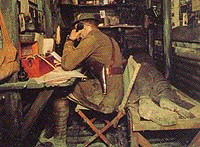 They hear us telling each other that there isn't a tree over eighty years old as far as the eye can see and that there isn't one square yard of soil beneath our feet that wasn't a shell hole. They suggest we walk into the woods where the moonscape terrain of pits and hollows still survives in the undergrowth.
They hear us telling each other that there isn't a tree over eighty years old as far as the eye can see and that there isn't one square yard of soil beneath our feet that wasn't a shell hole. They suggest we walk into the woods where the moonscape terrain of pits and hollows still survives in the undergrowth.
They confirm that, yes, it's true, not one house, church or farm stood more than a couple of feet above its foundations after four years of artillery pounding and that everything you see is rebuilt.
They watch us trying to imagine the scene: the columns of men and mules marching out of Albert past the juggernaut batteries of heavy artillery and the field hospitals as they the zig-zagged their way through the support trenches to the mud and miles of duck-boarding and barbed wire entanglements that led to the stench of sewage, rotting horse-flesh and the dismembered corpses of 23 year-old grandfathers.
"Our Front Line was there, where your mother's standing," a father explains, peering at a reproduction of Field Marshall Haig's own deployment maps. "The German line must have been just there... yes, where you are, Jane," he tells his daughter. "Just about thirty yards... so you see they could hear each other having breakfast."
 The twin black lines on the map right show how close the parallel British and German lines were along much of 'the Front', often around 20 metres. Lochnagar Crater, which can be seen today, is a millimetre or two off the bottom centre edge of this map – due south of the words 'La Boisselle'. Regrettably, its twin, 'Y Sap' – marked as a star-shaped feature on the north side of the Albert road – has now now been filled in by farmers with little interest in the great events that occurred on their land.
The twin black lines on the map right show how close the parallel British and German lines were along much of 'the Front', often around 20 metres. Lochnagar Crater, which can be seen today, is a millimetre or two off the bottom centre edge of this map – due south of the words 'La Boisselle'. Regrettably, its twin, 'Y Sap' – marked as a star-shaped feature on the north side of the Albert road – has now now been filled in by farmers with little interest in the great events that occurred on their land.
In the town of Albert, just a couple of miles behind the lines, they have a better understanding of this peculiarly British preoccupation. Albert, too, seems to have lost its way. Somehow the old British garrison town has been bypassed by the French economic miracle leaving it stunned and despairing as the effects of the recession and massive unemployment take their toll. But it makes a comfortable and familiar base for today's British visitors, just as it did for hundreds of thousands of troops before they marched out of it and up the Bapaume road to join 750,000 other British troops in a squalid, pointless death in the trenches.
 Albert understands the British. Mr and Mme Dutoith have made a very successful living from their almost exclusively British clientèle at the Grand Hôtel de la Paix by shrewdly ensuring that the hotel is almost indistinguishable from an English seaside boarding house in c.1950.
Albert understands the British. Mr and Mme Dutoith have made a very successful living from their almost exclusively British clientèle at the Grand Hôtel de la Paix by shrewdly ensuring that the hotel is almost indistinguishable from an English seaside boarding house in c.1950.
Little here seems to have changed since the 'Liberation' in 1944 – and that, it seems, is how the English, however well-heeled, prefer it. Could it be that it reminds them of some better, happier, more innocent world they think they once knew at home? Scattered in the hallway and on quietly disintegrating sofas are helpful, well-thumbed battlefield guidebooks and the memoirs of veterans.
Right above and below: World War ll scarcely affected the landscape of the Somme – unlike other parts of the Western Front. At the Serre No.2 cemetery, there is a link between the conflicts. A gardener's shed tucked away behind the portico in the south-east corner was a perfect hiding place for an airman, shot down and on the run, in World War ll – see: Escape & Evasion.
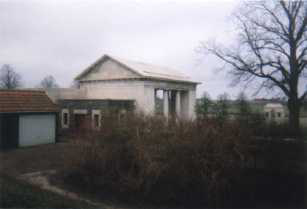 I head out of Albert, down the Ancre Valley, to a tiny isolated cemetery in a fold in the hills with breathtaking views to visit my great-uncle, Capt. Basil Andrew Long of the King's Own Royal Lancashire Regiment. I find I am not alone. A delightful young family of four, from Yorkshire, is sitting in the sun having just discovered the one headstone they have come all this way to find.
I head out of Albert, down the Ancre Valley, to a tiny isolated cemetery in a fold in the hills with breathtaking views to visit my great-uncle, Capt. Basil Andrew Long of the King's Own Royal Lancashire Regiment. I find I am not alone. A delightful young family of four, from Yorkshire, is sitting in the sun having just discovered the one headstone they have come all this way to find.
"What shall I write?" asks the mother, pen poised over the visitors' book.
"Whatever you like," her husband replies. And so, for a man that even her mother's mother never knew, she writes: 'Bless you – RIP' – as thousands of others do every week.
And then comes the Big Bang. Their daughter, who has been absorbed by the Register of names and the details of everyone in the cemetery, asks the question that her parents have been dreading: "But why exactly were they fighting?"
Her parents don't know. They can't remember.
Like me and thousands of others, they just know that for some indefinable reason it was necessary to come here. And perhaps they would agree that there is wisdom in an old soldier's dictum: 'If you lose your direction: stop. Go back to the start and set out again'.
Christopher Long was a war correspondent in the Balkans for British press, radio and TV throughout the hostilities, 1991-1999.
Notes
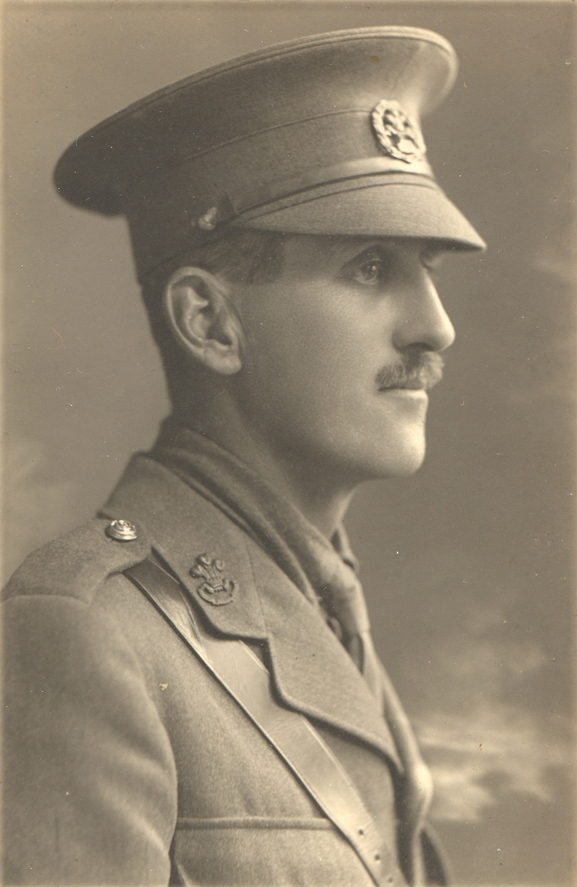
Capt. Basil Andrew Long
Capt. Basil Andrew Long survived the Battle of The Somme in 1916 but died the following year in a field hospital at Heilly, near Méricourt L'Abbé, where he is buried at Heilly Station (War) Cemetery, about seven miles west of Albert.
 The picture (left) shows him in the uniform of 9th Battalion South Lancashire Regiment from which he was transferred to the King's Own Royal Lancaster Regiment – one of the famous 'bantam' regiments – (by which time, perhaps, the picture right was taken).
The picture (left) shows him in the uniform of 9th Battalion South Lancashire Regiment from which he was transferred to the King's Own Royal Lancaster Regiment – one of the famous 'bantam' regiments – (by which time, perhaps, the picture right was taken).
His cemetery citation reads:
"LONG, Capt. Basil Andrew. 11th Bn. King's Own Royal Lancaster Regt. Died of meningitis 10th Feb., 1917. Age 42. Son of the Rev. David Long and Clara Elizabeth Long. Graduated at Gonville and Caius College, Cambridge. Headmaster of Heathmere Prep. School, Haywards Heath [England]. Gazetted to Commission in 9th Bn. South Lancashire Regt. in April, 1915, and transf. in April, 1916. Born at Croydon, Surrey. Vl. A. 11."
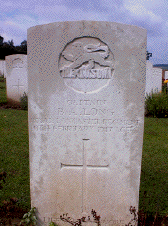 Basil, survived the Battle of the Somme in 1916, but contracted meningitis at the front (where?) and was taken by train via Albert back to the relative safety of the Heilly casualty clearing hospital, though not back to Amiens and London as would have been the usual hope. Meningitis was endemic and invariably fatal in these conditions.
Basil, survived the Battle of the Somme in 1916, but contracted meningitis at the front (where?) and was taken by train via Albert back to the relative safety of the Heilly casualty clearing hospital, though not back to Amiens and London as would have been the usual hope. Meningitis was endemic and invariably fatal in these conditions.
Basil's battalion later took part in the 1917 advance towards Cambrai: 24th-25th April 1917: 11th Battalion King's Own was part of (Brig-Gen. the Hon. C. S. H. D. Willoughby's) 120th Brigade and (Maj-Gen. Ruggles-Brise's) 40th Division of (Rawlinson's) 4th Army. At 4.20 am on 21st April 1917, 120th Brigade (with 25th Brigade) took part in the attack on Gonnelieu, towards Villers Plouich (captured by 13 East Surreys on 24-04-17) and Beaucamp on either side of the Couillet Valley, famous in the Battle of Cambrai as Welsh Ridge and Highland Ridge. Beaucamp [sic] had been entered but then lost by 14 Argyll & Sutherland because of heavy bombardment by the enemy from Bilhem, a collection of farm buildings within a 25-acre enclosure east of Trescault. Originally Bilhem was supposed to have been captured by 20th Division but Maj-Gen. T. G. Matheson ordered the attack for 11 p.m. After artillery bombardment the 12 King's Royal Rifle Corps attacked the farm through a gateway, taking 14 prisoners and a machine-gun. Next morning (25-04-17) the 11th King's Own of 120th Brigade re-took Beaucamp [sic].
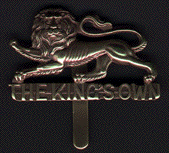 The King's Own Royal Regiment (4th Foot – Lancaster) was raised for service in Tangiers in 1680 and served in the Peninsula War, at Waterloo, the Crimean War, the Indian Mutiny, the Boer War and in both World Wars. In 1959 the King's Own merged with its neighbour The Border Regiment to become the King's Own Royal Border Regiment.
The King's Own Royal Regiment (4th Foot – Lancaster) was raised for service in Tangiers in 1680 and served in the Peninsula War, at Waterloo, the Crimean War, the Indian Mutiny, the Boer War and in both World Wars. In 1959 the King's Own merged with its neighbour The Border Regiment to become the King's Own Royal Border Regiment.
According to Iain Kerr (writing in 1999): 'The 11th (Service) Battalion of The King's Own (Royal Lancaster Regiment) was formed at Lancaster in August 1915 as a 'bantam' battalion, consisting of men who were below the pre-war height limits for recruits. Many of these were miners or mill workers – stunted by poor diet and social conditions. They were led by officers drawn from conventional regiments. The battalion moved to Aldershot as part of 120th Brigade in the 40th Division and were based at Blackdown, Lancs. On 2 March 1916 the battalion absorbed the 12th (Service) Battalion, The South Lancashire Regiment, (another 'bantam' battalion raised in Warrington in June 1915). This would account for Capt. Long's transfer in April 1916. The 11th Battalion landed in France on 3 June 1916 and was disbanded on 7 Feb 1918. The remaining personnel transferred to 6th Entrenching Battalion. The 9th (Service) Battalion, The Prince of Wales' Volunteer (South Lancashire) Regiment was briefly in France (7 September 1915 to 29 October 1915) and then departed from Marseilles for the Salonika front, where they spent the rest of the war'.
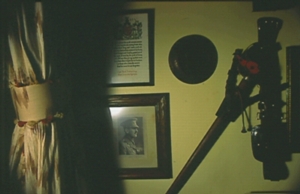 The author has his Wilkinson dress sword (see right) inscribed by parents and staff of Heathmere School (where he was headmaster), and the 'standard issue' roll of honour citation and a bronze memorial plaque issued to the families of those serving officers who were killed or who died in active service.
The author has his Wilkinson dress sword (see right) inscribed by parents and staff of Heathmere School (where he was headmaster), and the 'standard issue' roll of honour citation and a bronze memorial plaque issued to the families of those serving officers who were killed or who died in active service.
In addition the author has Basil's silver-mounted cigarette box, an initialled silver vesta box and a number of items of leather and webbing equipment some of which appear to have belonged to Basil while some probably belonged to an NCO or private soldier – probably Basil's soldier servant who may have died with him. Basil's initialled silver cigarette case sadly 'vanished' in London in the 1980s...
Heilly, Near Albert, The Somme.
In 1996 I met 94 year-old Lucien, a former gardener at Heilly chateau who remembered the British military hospital near Heilly Station and was able to direct me to it – about 250 yards north of the cemetery, immediately along the north and south side of the tracks. It stretched a hundred yards or so east and west of the level crossing. All that remains now are a few piles of rubble. A large ruined concrete structure at the far western end of the site survives and is thought to have been used for loading artillery shells from trains onto lorries destined for the nearby front. Presumably the same trains might have carried the injured back to Amiens and the Channel ports. Lucien was 12 or 13 at the time and, with other young boys, spent much time around the front lines scavenging for the heavy brass 'timers' found on the noses of unexploded shells. Colour markings distinguished the deadly mustard gas shells from the 'safer' high explosive varieties. Items like these could be sold for a few francs to scap metal merchants in Amiens and kept whole families supplied with bread. Lucien, who remembered the deep antagonism and constant scrapping between Australian and British troops, was also one of the first on the scene when the German air-ace Baron Manfred Von Richthoffen crashed to his death near a brick-works in a field south of Bonnay, a mile or two away.
The 36th Casualty Clearing Station was at Heilly from the 1st April 1916 to April 1917. It was joined in May by the 38th Casualty Clearing Station, and in July by the 2/2nd London. The last hospital left Heilly in June 1917 but the 20th Casualty Clearing Station was there in by September 1918.
The cemetery was begun in May 1916, and was used by the three medical units until April 1917. From March to May 1918 it was used by Australian units and in the early autumn for further hospital burials. The last British grave was made in May 1919. A small German Plot, near the north-west corner, containing 13 graves of 1918-19 was removed after the Armistice. There are now 3,000 1914-18 war casualties commemorated in this site. Of these a small number are unidentified and special memorials are erected to fifteen soldiers from the United Kingdom, four from New Zealand and two from Australia, whose graves could not be exactly located. The regimental badges, numbering 117, are carved on a cloister wall on the North side. The cemetery covers an area of 6,210 square metres and is enclosed on three sides by a red brick wall.
The Battle of The Somme
This in fact consisted of several offensives from 1st July to 18 November 1916, was conceived by the French commander-in-chief, Joffre, in late 1915 and adopted, despite some reservations, by Field Marshal Sir Douglas Haig, the newly appointed commander of the British Expeditionary Force (BEF). The offensive stretched along a line about 20 miles (30 kms) from the River Somme north to a point several miles beyond its tributary, the River Ancre. Throughout the length of this line the Germans held excellent positions on high ground and had developed a sophisticated system of well-defended, deep concrete bunkers below occupied villages (e.g. Gommecourt, Beaumont-Hamel, Thiepval, Ovillers, Pozières, La Boiselle, Fricourt, Mametz and Longueval).
Originally planned as a joint British/French operation to ease massive pressure on the French at Verdun, the Battle of the Somme eventually became an overwhelmingly British operation with some French support at the southern (Somme) end of the line. The plan was that an eight-day, non-stop artillery barrage would cut German barbed-wire entanglements and utterly destroy German front-line positions. Around 750,000 troops (from 27 divisions) would then advance almost unopposed to capture Bapaume where retreating Germans would find themselves pushed into chaos behind their own rear-lines along a 40-mile salient. This would sever the northern wing of the German line (on the Belgian border) from its southern wing (on the Meuse and at Verdun), cutting German communications allowing the Allies to make encircling and pincer movements to neutralise enemy strength in northern France.
The eight-day bombardment made scarcely a dent on the German Second Army front lines because the enemy simply sheltered underground and re-emerged with machine-guns to mow down the advancing British troops. Furthermore, the barbed-wire was largely untouched – not least because a large percentage of sub-standard shells never detonated (hence the large numbers of live shells still found in the area to this day). In addition, many British attacks had to be made through 'woods' (e.g. Mametz Wood, High Wood, Delville Wood). Though scarcely recognisable as such – because not a single tree or building survived intact anywhere on the front – these terrifying, stump-ridden hell-holes were atrociously difficult to advance through and provided perfect cover for German machine-gun positions.
In hindsight and from the British viewpoint, it was the wrong battle (effectively like sending cavalry against tanks) in the wrong place (an offensive near the Channel might have worked well) at the wrong time (it happened to be one of the wettest summers on record). It was fought by an under-trained, inexperienced British volunteer army, supplied with poor quality artillery shells, advancing over rivers, marshland and deep clay mud, across often impassable terrain to launch uphill assaults against a well-defended and deeply dug-in enemy.
Worst of all, British commanders had no contingency plan should the opening stages fail and appeared quite inflexible in the face of failure – hence the almost incomprehensible policy of launching one doomed attack after another in which, day after day, tens of thousands of men were systematically mown down in waves by machine guns. Most never reached the opposing front lines. Huge numbers were wounded by artillery shrapnel, machine-guns, snipers, but were never found and often drowned in the slippery-sided, water-filled shell-holes. Gas attacks killed hundreds at a time.
Thousands more died when company commanders ordered attacks through the few holes in German barbed-wire entanglements. These holes provided perfect targets for German machine-gunners who only had keep guns pointed on the holes and their triggers squeezed.
The only solid success of the five-months of carnage was the extraordinary courage and endurance of the troops and their junior officers at the front. Life expectancy for officers at The Somme (and at the Third Battle of Ypres – 'Wipers') was a few weeks. Life expectancy for their men was a couple of months.
The Statistics are appalling. The battles of The Somme, gained a crescent of shattered, uninhabitable land about 16 miles deep at its widest point – all of which was later lost again. This 'gain' cost 420,000 British casualties, 200,000 French casualties (the French having supported the battles on the southern tip of the front around the River Somme) and an estimated 500,000 German casualties. The first day of the main offensive on 1st July 1916 resulted in more than 60,000 British casualties alone – almost 20,000 of them killed – more than on any other day in British military history.
Visitors to Albert, The Somme
Those wanting simple, reasonably-priced accommodation, should consider 'Au Coin du Feu' in the tiny village of Heilly (about 7 miles west of Albert and about 1 mile south of the main road from Amiens to Albert). Until 1999 it was offering a warm welcome, pleasant and simple rooms in converted stables and excellent cooking – all at very reasonable prices (tel: +33 3 2240 6104). From here the entire Somme 'front' is within a radius of 10-12 miles (check that it is still operating B&B facilities).
British visitors in particular can expect a warm welcome from Martine & Régis at the café 'Le Bugatti' at 22, Avenue de la République, Albert (tel: +33 3 2275 0964). Close to the centre, it remains open till a sensible 1:00 am.
Conveniently close to the 'Musée des Abris' in Albert (see below) is the café 'Aux Trois Pigeons' just on the other side of the Basilique from the museum entrance. Its owner, Thiérry Gaudefroy, speaks passable English!
Out on the front lines, in the village of Pozières, is 'Le Tommy' café and bar. It's a bit of a tourist-trap but has an interesting mock-up of trenches in the garden and plenty of old WWl kit, artillery pieces, trench-mortars, maps and memorabilia to keep youngsters occupied while the adults take a coffee break and try to come terms with what they've been seeing. Dominique & Melanie Zanardi can also arrange sandwiches for group visits if called in advance – tel: +33 3 2274 8284.
Words of Warning & Encouragement!
The battlefields of World War l are still littered with débris including unexploded munitions. If you find things of this sort anywhere, don't touch them. They can still be very dangerous. Farmers regularly plough up quantities of shells, rusting weapons and other 'mementoes' – including, sadly, human remains. The shells are usually left in the corners of fields for disposal by the French army. The woods, largely untouched since the war, can still be dangerous in places too – the ground being extremely uneven with hidden craters and trenches which still harbour deadly viruses.
If you want memorabilia (ranging from cap badges and water-bottles to spent shell-cases and army-issue cutlery) these can be found at reasonable prices in the small market at the Musée des Abris under the Basilique in the centre of Albert. This excellent museum, created by enthusiasts, is the best of its kind that I have seen and the ideal place to start and finish any tour of the Somme battlefields. [The Musée des Abris is open every day from 1 March to mid-December (9:30-12:00 + 14:00-18:00 and from July to August 9:30-18:00] see below for more details, in French!
Beware of Flags
Unfortunately nationalism is yet again rearing its ugly head on the battlefields of the Western Front. Countries such as Australia, Canada, Newfoundland, South Africa and the United States are among those that are increasingly flying their national flags over cemeteries and even whole sectors of the front lines. It appears that they have learnt little from the history they purport to honour.
The carnage of World War l was entirely the consequence of flag-waving nationalism and it is grossly impertinent that individual countries attempt to claim flag-waving sovereignty over areas in which men of many different units and countries took part and died in their millions.
Fortunately the Commonwealth War Graves Commission has resisted this trend and the British union flag is seldom seen. Visitors should not be misled by flags in northern France. The majority of the Australian, Canadian, Newfoundland, South African and USA troops killed on the Western Front were never found and still lie where they fell. Thousands more lie in discreet, dignified and flagless CWGC cemeteries, side by side with men from all over the world – just as they were when they died.
What Can We Still See?
This is the question most visitors ask. The answer is that if you do not know what to look for you will probably not see anything at all that indicates that devastating battles took place here – apart from the presence of literally hundreds of CWGC and other cemeteries.
Alternatively, if arm yourself with a good battlefield guide and chat up other enthusiasts and local people, you will find subtle evidence all around you. Since the late 1970s, deep ploughing has all but destroyed visual evidence of the zig-zag trench lines across the fields of Picardy which were once very evident.
However, some idea of the moonscape that once covered thousands of square miles can be grasped from a visit to the Lochnagar Crater, the preserved landscape at Beaumont-Hamel (the Highland Division and Newfoundland memorial parkland) and out-of the-way areas that modern agriculture hasn't yet reached. Sadly, French farmers have left little to remind themselves of great events in their own recent past – a heritage that ought to be as important to them as it is to the rest of us.
The only features that are often clearly visible today are the artillery 'levées' – the long, flat areas, set behind earthworks or natural features, that gave protection to lines of heavy gunnery. These often run close to, or parallel with, small lanes, about 7 metres wide and perhaps 3 to 6 metres below the enemy's line of sight. They usually indicate fairly permanent Allied or German defensive or offensive positions.

Artillery 'Levées' from the final offensives of 1917-18, north of Dernancourt, on the River Ancre.
Information & Museums
Hundreds of general and specialist books on the First World War have emerged over the years, many still in print. Strongly recommended is the excellent guide/companion to any tour of the Western Front: 'Before Endeavours Fade' by the admirable Rose E. B. Coombs, MBE, (ISBN 0-90091-85-1) and available in many book shops and at the Imperial War Museum, London. For visitors who read French and plan to visit the small villages which were obliterated by the battles of the Somme, 'Albert et Ses Environs' by Jean-Michel Declercq (ISBN 2-84253-132-9) is a delightful paperback compilation of original postcards produced before and during the war.
The 'Historal' museum at Péronne, devoted to the First World War in France, may appeal to some tastes – though not mine. It appears to have been designed for tourists and its creators do not seem to have appreciated that most non-French visitors to the Somme come as visitors, usually with deeply personal reasons for being there. Attempts to condense a colossal tragedy into a one-hour, package-tour spectacle (hoping too that the German tourists in particular will feel better about themselves) is no substitute for a quiet wander around the lanes, woods, fields and villages in which these epic events took place and where too many of those involved still lie where they fell.
However, the very best introduction to the battle is the Underground Musem in Albert, housed in long tunnels beneath the Basilica in the centre of Albert. This excellent museum is crammed with original material, reconstrctions of trench life, maps, photographs, weaponry, munitions and the 'detritus' of war. It was founded by amateur collectors and is invaluable both before and after a visit to the Front which is a mile or so east of the town centre (see details, in French, below).
L'historique du Musée des Abris, Albert: Sous l'impulsion du Maire d'Albert, Stéphane Demilly, et l'idée de quelques benevoles Albertins, un musée était crée pour rendre hommage aux combattants de la guerre de 1914-18 et surtout les 750,000 Britanniques qui tombaient pour la défense de la France.
Le musée a pris forme en début de l'année 1992. Thierry Gourlin (chef du Corps des Sapeurs Pompiers d'Albert) et Pierre Quelin accompagné des RMIstes entreprennent pendant six mois des travaux de réfections et de mise en conformitée d'un sous-terrain. Ce tunnel était un des septs souterrains anti-aerien de secours, a une longueur de 230 m, était creusé pour la population locales qui travaillaient à l'époque pour l'industrie aeronautique (Potez) et militaire du village de Méaulte. Il démarre sous La Basilique Notre Dame de Brebières, continue par la Place d'Armes pour déboucher par les anciennes fortifications de la ville dans le jardin public.
Celui-ci offre un panorama de vestiges et de scènes de 1914-18 acheté aux collectionneurs de leurs collections personels pour enrichir ce site sans cesse grandissant et surprennant tant par sa diversitée et sa situation souterraine. Aujourd'hui il se constitue d'une quinzaine d'alcoves transformées en scènes de tranchées, et 18 vitrines nous montrent les objets, le matériel et les armes de cette époque. L'atmosphère y est surprenant et troublant de vérité.
Le Musée a ouvert ses portes le 1 juillet 1992 – pour commemorer la grande offensive alliée de la Somme le 1 juillet 1916 – et a accueillit 10,000 entrées cette année là. En 1998 le musée a enregistré 32,000 entrées avec 60% de fréquentations Britanniques.
L'entrée du Musée est situé à proximité de la Basilique. C'est donc à 10 metres de profondeur que vous pourrez découvrir.
Ouvert 7 jours/7, du 1 Mars au mid-Décembre 9h.30-12h 14h-18h (Juillet et Aout 9h30 à 18h). Tarifs: adulte FFr.20, enfant 6 à 18 ans FFr.10, groupe à partir de 15 personnes FFr.15. N'oubliez pas de visiter la boutique souvenirs où vous pouvez acquérir des objets militaires d'époque et original.
Tel: +33 (0)3 22 75 16 17 – Fax: +33 (0)3 22 64 00 46.
See Review of World War l Videos
See Feedback reactions to this page
To Search Commonwealth War Graves Commission Archives
© (1996) Christopher A. Long. Copyright, Syndication & All Rights Reserved Worldwide.
The text and graphical content of this and linked documents are the copyright of their author and or creator and site designer, Christopher Long, unless otherwise stated. No publication, reproduction or exploitation of this material may be made in any form prior to clear written agreement of terms with the author or his agents.














